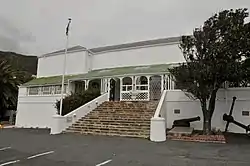Simonstad Museum | |
 | |
| Established | 1977 |
|---|---|
| Location | The Residency, Court Road, Simon's Town |
| Coordinates | 34°11′29″S 18°25′39″E / 34.191366°S 18.427567°E |
| Type | Community museum |
| Curator | Cathy Salter-Jansen |
| Public transit access | Simon's Town Railway station |
| Nearest car park | Carpark in Court Road, outside the Simon's Town Museum |
| Website | Official Website |
Established in 1977, Simon's Town Museum is a community museum situated in Simon's Town, a coastal town in the Western Cape Province of the Republic of South Africa. It is a province-aided museum which receives support from the Government of the Western Cape Province.
History
The Simon's Town Museum was established in 1977 by a group of enthusiastic volunteers, the MOTHS (War veterans of the Memorable Order of Tin Hats) of the “Snoekie Shellhole” and the Simon's Town Historical Society.[1] At first, the Simon's Town Museum was located in the old Headmaster's house, but its rapid expansion led the board of trustees to look for new premises. They bought and renovated The Residency, an historical building erected by Governor Joachim van Plettenberg in 1777, to serve as the winter residence of the Dutch East India Company Governor at the Cape of Good Hope, when on official business at Simon's Bay. To date, it remains the home of the Simon's Town Museum.
Function and themes
The Simon's Town Museum records and preserves all aspects of the history of the Simon's Town community and portrays the vibrant past of this small, maritime port, whose position on The Cape Sea Route, resulted in a history which is intertwined with that of many nations around the world.
Development of Simon's Town
From its earliest days Simon's Town was very cosmopolitan in nature. Consequently, the Museum depicts pre-colonial history, the establishment of the refreshment station at Simon's Bay by the Dutch East India Company in 1743 and the First and Second British Occupations, from 1795 to 1803 and 1806 to 1957 respectively. The Royal Navy established a permanent base at Simon's Town in 1813 and remained for 144 years.
Apartheid
The greatest tragedy to befall the people of Simon's Town, was the Forced Removals under the Group Areas Act by the Apartheid government in 1967. It led to the devastation of the Simon's Town community. One of the Simon's Town Museum's most important undertakings has been Project Phoenix.[2] It was launched in 1996 to record and preserve the history of the former residents of Simon's Town and added much new material to the Museum's collection. Former residents, museum staff and volunteers meet regularly and work together to ensure that the Museum's collections become more representative of the Simon's Town community.

Other activities
In addition to its exhibitions and projects, Simon's Town Museum undertakes a number of education and outreach programmes and regularly provides activities linked to South Africa's national days.

See also
References
Citations
- ↑ "Simon's Town". Simons Town. Retrieved 20 August 2014.
- ↑ "Project Phoenix". Simons Town. Retrieved 20 August 2014.
Further reading
- Sean Field (2002). Lost Communities, Living Memories: Remembering Forced Removals in Cape Town:David Phillips Publishers
- David Briggs(1999). This Is Cape Town: New Holland Publishers Ltd
- Todeschini and Japha(1992).Simon's Town: Guidelines for conservation and development: Oakville Publishers
- Boet Dommisse, Tony Westby-Nunn(2002) Simon's Town:An illustrated historical perspective: Westby-Nunn Publishers
- Michael Walker(1998)Simon's Town:A postcard history 1900−1913M: J. Walker
- Kenneth Hudson, Ann Nicholls (1985).The directory of museums & living displays: Macmillan
- Madeleine Barnard (2007). Cape Town Stories: Local flavours from the Peninsula. Struik Publishers.